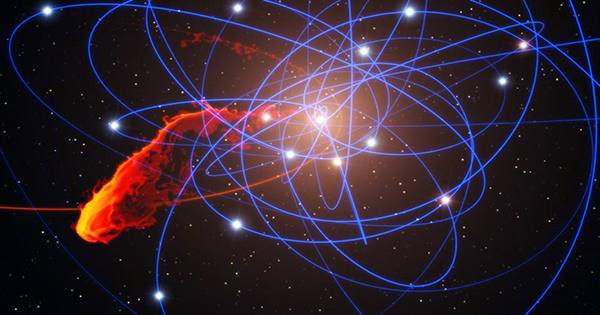Let us set the scene: we move to the center of the Milky Way. Sagittarius contains A (SGR A ), which lies in a supermassive black hole 4.6 million times the mass of our own Sun. It orbited by a young star, the S-cluster, including one called the S50. Researchers are now observing for the first time how this star is interacting with the complex environment surrounding the black hole. Twenty years of observing a strange feature around Sagittarius A * called X7, researchers in the world have reported in the Astrophysical Journal. It is the push of a bow – the collision between the supersonic material and the interstellar plasma surrounds the supermassive black hole. Researchers have worked out that the X7 is the S50’s terrestrial envelope.
The exciting thing is that the size of the X7 is also changing over time. In fact having data is very important for observing this rare dynamic interaction, as it provides us with clues about exactly what is happening at the very center of our galaxy. “We noticed for the first time the interaction of a young star with the environment of the supermassive black hole SGRA A *. This interaction is unexpected and highlights the uniqueness of clusters (or S-clusters),”lead author Dr. Florian Pecker from Cologne University told IFLScience.
“In the future it could help to understand the process and activity of star formation near a supermassive black hole. Furthermore, we see that the young star’s dust shell appears to have disintegrated. Such a dynamic process on this scale has never seen in this region. This search will help to understand the evolution of young stellar objects at the Galactic Center.” The team believes that the change in size is due to the wind. It is not your regular air that you can experience outside, but a stream of charged particles. If the excitatory process starts, its source may be the region near the supermassive black hole. Another option is that the air comes from a group of mass-losing hot stars known as IRS 16, and the black hole simply blows that air towards X7 because of its massive mass.
“There are two possibilities: either the black hole bends space-time and affects the wind direction of the star from IRS16.” Dr. Pierre explained IFLScience. “Or, SGR A * is creating the air itself which creates the shape factor. Therefore, we need more information to see how the X7 / S50 system behaves.” SGRA * is located about 26,700 light-years from Earth, and in the last decades we have begun to learn so much about the stars that it orbits it and even tests its general relativity. Uninterrupted observation with current instruments, data from the Event Horizon Telescope, and incoming observations will help crack its mystery even further.















